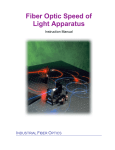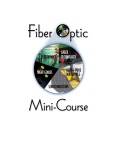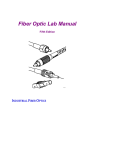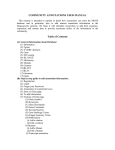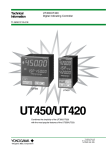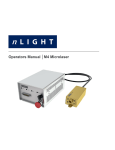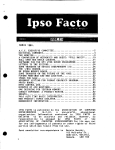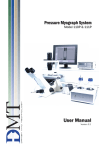Download IF-E22 - Industrial Fiber Optics
Transcript
EDUCATIONAL COMMUNICATION KIT RADIANT ENERGY IN ACTION A Hands-On Introduction to Fiber Optics Communications • • For the Classroom For the Hobbyist INDUSTRIAL F IBER OPTICS * Copyright © 2000 Industrial Fiber Optics, Inc. * * * All rights reserved. No part of this publication may be reproduced, stored in a retrieval system, or transmitted in any form or by any means without express written permission from Industrial Fiber Optics. * * * INDUSTRIAL F IBER OPTICS 627 South 48th Street, Suite 100 Tempe, AZ 85281 * * Table of Contents Preface .................................................................................... ii OBJECTIVE ............................................................................ 1 STARTING OUT .................................................................... 1 TOOLS AND TEST EQUIPMENT YOU'LL NEED ...................................................................................... 1 PARTS LIST ............................................................................ 2 ASSEMBLY INSTRUCTIONS ............................................... 2 EXPERIMENTS AND ACTIVITIES...................................... 6 "NUTS AND BOLTS" OF FIBER OPTICS .......................... 10 GLOSSARY ............................................................................. 20 REFERENCES ........................................................................ 22 ADDITIONAL PRODUCTS .................................................. 24 SHIPPING DAMAGE/MISSING PARTS CLAIMS............. 26 * * ii * Preface Fiber optics technology is rapidly becoming a familiar and indispensable part of American life. Long-distance telephone companies can't say enough good things about the bold new technology that has revolutionized communications systems across the county and, not far in the future, will span the globe. Futurists, science writers and entrepreneurs forecast fantastic growth for fiber optics applications. And their enthusiasm is valid. Today, medical fiber optic systems allow physicians to peer inside the human body without surgery. Military commanders demand portable battlefield communications systems which use superior fiber optic transmissions. The massive bundles of copper wiring which once carried telephone conversations between continents, beneath the oceans, now are being replaced with much smaller optical fibers. Fiber optic amplifiers with higher bandwidth and greater reliability are replacing electronic repeater stations. The next decade promises even more wonders. The influence of fiber optics will pervade our homes, workplaces and recreational facilities. Your television reception will take on startling clarity and increased resolution. Newsprint may largely become a thing of the past as environmentally friendly and custom "electronic newspapers" become feasible. Two-way fiber optic systems will allow you to "attend college" in the comfort of your home as well as enjoying faster download times when using the Internet. Anyone who takes an interest in fiber optics and pursues a career in the field today is on the ground floor of opportunity. The technology is sufficiently new that few "experts" exist. Increasing numbers of classes in fiber optics are being offered at the high school and university levels. The future beckons enticingly with the prospect of making new discoveries, finding new applications for the technology. This kit is an introduction to fiber optics communications for the instructor, student and hobbyist. We hope that you find the materials challenging, stimulating and—yes— even fun. ii Objective The purpose of this kit is to provide you hands-on experience with constructing basic fiber optic receivers, transmitters and cable interfaces, not unlike those used by telephone companies. This booklet contains a parts list; complete assembly instructions; some technical discussions about why everything here works as it does; and a glossary of terms used. You will learn how and why light can be "captured" and transmitted by lengths of optical fiber. With the basic information you gain, you can go on to more sophisticated discussions and demonstrations of fiber optics in action. Starting Out In preparing this manual, we assumed you have a basic grasp of digital and transistor circuits. If these topics aren't your strong points, you may choose to skip some of the theory and exercises. You'll still be able to construct the kit and learn the most important fundamentals of fiber optics. Consult the Glossary in the rear of the manual if you're uncertain about the meanings of technical terms. When you have completed this kit and demonstrations, we hope you'll want to move up to more advanced material. See page 24 in this manual for a list of other exciting fiber optics products available to you. Portions of this kit call for the use of an oscilloscope to perform demonstrations and to make some of the measurements. If you don't have, or want to use an oscilloscope, you can make two changes which will still permit you to conduct the demonstrations. First, solder a 10 µf axial-leaded electrolytic capacitor to the transmitter printed wiring board, at the location marked "optional". Second , so lder an LED acros s the outp ut p ins on t he recei ver marked "Dat a" and "Dat a Bar" (po larity is not i mport ant) . During operat ion, t he LED wil l bli nk on an d off with the trans mitter circu it. The visual blinking of the LED is comparable to the waveform as would be seen on an oscilloscope. Tools and Test Equipment You'll Need Wire cutters Needle-nose pliers Small Phillips screwdriver Small adjustable wrench 1 ml water or light oil Rosin-core solder Single-edge razor blade or sharp knife 25-watt soldering iron 18-gauge wire-stripper 5-volt DC power supply Dual-trace oscilloscope Four electrical clip-leads 1 Parts List Your kit should contain all the components listed in the table below. Table 1. Parts list. P/N C1 D1 H1 H2 F1 H3 Q1 Q2 Q3 R1 R2 R3 R4 R5 R6 R7 U1 U2 Description Color-code Mylar ® capacitor IF-E96 2N3904 IF-D92 2N3904 220 K 33 K 3.9 K 33 K 100 Ω 33 K 1K 4093 4093 .01 µf Fiber optic red LED Two 2/56 screws Two 2/56 hex nuts 1-meter 1000 µm plastic fiber 600 grit polishing paper NPN transistor Fiber optic phototransistor NPN transistor 1/4 watt resistor 1/4 watt resistor 1/4 watt resistor 1/4 watt resistor 1/4 watt resistor 1/4 watt resistor 1/4 watt resistor Quad CMOS Schmitt Quad CMOS Schmitt Pink Dot White Dot Red Red Yellow Orange Orange Orange Orange White Red Orange Orange Orange Brown Black Brown Orange Orange Orange Brown Black Red Assembly Instructions Printed Wiring Board Follow the guidelines below when assembling your kit: • Mount all components on the side of the printed wiring board with the white lettering. (Solder Side.) • Use the white markings on the printed circuit board to determine the location and orientation of each part. (Component Side.) • All soldering is to be completed on the opposite side. • Use a water soluble or rosin core solder such as Radio Shack P/N 64-001. Do not use an acid or caustic flux solder such as used in industrial or plumbing applications. • Avoid applying prolonged heat to any part of the board or component, to prevent damage. 5 Seconds maximum. • After soldering each component, trim its lead length flush with the solder. 2 Resistor Capacitor 1 Integrated Circuit Transistor Figure 1. Component identification: resistors, capacitors, ICs. Board Assembly Steps 1. Insert resistors R1 through R7, one at a time, into the printed wiring board and solder them in place. 2. There is no positive/negative orientation of capacitor C1. Identify, insert leads through the board and solder in place. 3. Identify pin 1 of U1 and U2 (the lower left pin of the integrated circuit [IC], when viewed from above). Insert the ICs into designed spots marked on the printed circuit board, with pin 1 to your lower left. The lettering on the ICs will face the same direction as the markings on the board. Solder in place. 4. Identify Q1 and align the package design with the detail on the printed wiring board. Insert and solder. 5. Clean the printed circuit board with soap and warm water to remove solder residue. Soapy water will not harm the components as long as electrical power is not being applied–in which case you don't want to get anywhere near water anyway, for safety's sake. If you used a rosin core solder, clean the board with the denatured alcohol before washing in soap and water. Rinse thoroughly. Shake the board to remove water from under the ICs. Wipe everything dry with paper towels and let air-dry for 30 minutes. 3 6. Identify D1 as the blue fiber optic housing with the pink dot on one side. (The printed wiring board may have the part number IF-E91A marked on it instead of IF-E96.) Insert D1 in the designated area on the printed wiring board. Fasten in place with 2/56 screw and nut. Solder the leads. 7. Identify Q2 as the black fiber optic housing with the white dot on one side. Insert Q2 in the designated area on the printed wiring board. Fasten in place with 2/56 screw and nut. Solder the leads. 8. If you are going to operate this kit from one power supply, solder jumper wires from solder pads GND to GND, and +5V to +5V on the center left portion of the printed wiring board. If you want to use separate transmitter and receiver power supplies, break the two boards apart at the scribed junction. 9. Solder 24-gauge wires to the connections labeled +5V, GND, EN, EXT, DATA on the edge of each board. (If you have chosen to keep the boards together you will need to attach wires to only one of the two +5V and GND connections.) Figure 2. Board details on the printed wiring boards. 4 Fiber Preparation Instructions Each end of the optical fiber must be carefully prepared so it transmits light effectively. 1. Cut off the ends of the cable with a single-edge razor blade or sharp knife. Try to obtain a precise 90-degree angle (square). 2. Wet the polishing paper with water or light oil and place it on a flat, firm surface. Hold the optical fiber upright, at right angles to the paper, and polish the fiber tip with a gentle "figure-8" motion as shown in Figure 3. You may get the best results by supporting the upright fiber against some flat object such as a portion of the printed wiring board. (Don't insert the fiber ends into their connectors until we give you the word, in the next section.) Figure 3. Pattern and orientation of the optical fiber during polishing. 5 Experiments and Activities A1. Grasp the optical fiber near its tip with your thumb and forefinger. Point it toward a light source and different colored objects, while observing the other end of the fiber. Note the changes in brightness in that end as you move the other end around, or cover its tip with a finger. Do any colors seem to transmit better than others? A2. Holding the fiber about .5 mm (.020 inches)from this page, move it left to right across the heading of this section. What changes do you observe in the brightness at the other end of the fiber? With your power supply turned off, make the following connections with the electrical clip leads to the printed wiring board(s). • +5 volts to the positive terminal on the power supply • GND to the negative terminal on the power supply • EN to the negative terminal • EXT to positive terminal If you are using a variable voltage power supply, turn the voltage down to the minimum. Then turn the power supply on, and adjust the power supply to 5 volts. A3. Determine if the Transmitter LED (IF-E96) is on by measuring the voltage across R5. It should measure approximately 3 volts. If the LED does not have any current flowing through it, double-check the power supply, electrical connections, and assembly sequence. (You will be able to see the light being emitted from the LED if you through the hole that the fiber would be inserted.) A4. Insert one end of the optical fiber into the fiber optic LED, following the instructions in Figure 4. 6 Insert the prepared fiber end through the cinch nut and into the connector until the core tip seats against the molded lens inside the device package. Screw the connector cinch nut down to a snug fit, locking the fiber in place. Figure 4. Cross-section of fiber optic LED and cable. A5. In electronic design, multiple circuits often will achieve the same design goals. We'd now like you to design an alternative electronic LED drive circuit that will accept an external and oscillator input signal. Draw that circuit below. You may use Figure 9 as a reference. A6. What is the minimum output voltage at Gate d in Figure 9 necessary to ensure saturation of the LED drive NPN transistor? (Assume hfe= 50; Vce=0.2 volts; Vcc=5 volts; and V LED=1.5 volts.) 7 Insert the unattached fiber end into the fiber optic phototransistor, following the same steps in Figure 4. Connect the EXT and the EN inputs to +5 volts. Turn power on to the oscilloscope and set the horizontal time scale to .2 milliseconds per division and the vertical scales to 2 volts/division for both channels. Hook up one probe of a dual-trace oscilloscope to TP1 on the transmitter circuit and the other to TP3 on the receiver circuit. (You should see two square wave signals similar to those shown in Figure 5a.) Figure 5. Two oscilloscope traces of: a) transmitter TP1 (top) and receiver TP3 (bottom) signals; and b) receiver TP3 (top) and TP2 (bottom) signals. A7. Measure the transmitter board's oscillator period with the oscilloscope and calculate the oscillating frequency. Hz A8. Move Probe 1 located on the transmitter to TP2 (emitter of the phototransistor Q2) and observe the received signal as depicted in Figure 5b. Is the frequency the same? What does the signal at TP2 look like compared to TP3? A9. Measure the rise and fall time at TP2. Estimate or determine the maximum data rate this data link could transmit. (Hint: The answer can be empirically determined using an external function generator connected to the EXT input, or analytically determined, from the measured rise and fall times.) 8 A10. How would you change the sensitivity or gain of this receiver? A11. Connect the EXT input to + 5 volts and EN to ground. Measure and record the emitter voltage at Q2 of the receiver. Determine the minimum power input to the phototransistor base from the fiber (assuming its responsivity is 125 µA/µW) necessary to create this voltage. A12. What is the sensitivity of the phototransistor and common-emitter amplifier? (Assume the responsivity of Q2 is 125 µA/µW, and the hfe of Q3 is 50.) What are the dimensions (ft/sec, amps/volt) of this sensitivity? A13. Assuming that this transmitter launches 15 µwatts of energy into the fiber, a receiver sensitivity of 1.25 x 10-1 µwatts, and fiber attenuation 1 dB per meter, determine the maximum cable length this system can use. A14. If an optical radiometer or fiber optic power meter is available to you, disconnect the optic fiber from the receiver phototransistor and measure the optical power emanating from the fiber. Recalculate the maximum distance for which this data link can be used based on the actual measured power out of the 1-meter fiber. A15. Design a fiber optic transmitter and receiver circuit using PNP transistors and a negative 5-volt power supply. Draw your design below. 9 "Nuts and Bolts" of Fiber Optics Before fiber optics came along, the primary means of real-time data communication was electrical in nature. It was accomplished using copper wire or by transmitting electromagnetic (radio) waves through free space. Fiber optics changed that by providing an alternate means of sending information over significant distances–using light energy. Although initially a very controversial technology, fiber optics has today been shown to be very reliable and cost-effective. Light, as utilized for communications, has a major advantage because it can be manipulated (modulated) at significantly higher frequencies than electrical signals. For example, a fiber optic cable can carry up to 100 million times more information than a telephone line! The fiber optic cable has lower energy loss and wider bandwidth capabilities than copper wire. As you will learn, fiber optic communication is a quite simple technology, closely related to electronics. In fact, it was research in electronics that established the groundwork for fiber optics to develop into the communications giant that it is today. Fiber optics became reality when several technologies came together at once. It was not an immediate process, nor was it easy, but it was most impressive when it occurred. An example of one critical product which emerged from that technological merger was the semiconductor LED, of the type used in the educational kit which you have constructed. The following sections provide more detail about the electronics nature of a basic fiber optic data link, and the theory of operation for your Industrial Fiber Optics kit. Advantages of Fiber Optics Fiber optics has at least eight advantages over conventional copper cables: • Greater information-carrying capabilities • Smaller cable diameter • Lighter weight-per-cable length • Greater transmission distance • Immunity to electrical interference • Cables do not radiate energy • Greater reliability • Lower overall cost 10 Elements of a Fiber Optic Data Link Basically, a fiber optic data link contains three main elements: a transmitter, an optical fiber, and a receiver. The transmitter takes data previously converted to electrical form and transforms it into optical (light) energy containing the same information. The optical fiber is the medium which carries the energy to the destination (receiver). At the receiver, light is converted back into electrical form with the same pattern as originally fed to the transmitter by the person who wanted to send the message. It is important to note that optical energy can be beamed through the air or free space (like a flashlight beam). In fact, there are applications in which communication through air is used when installing optical fiber would be too costly or impractical. The advantage of optical fiber is that it allows light to be routed around corners and transported through obstructions (such as walls in buildings), just as household electrical and telephone wiring do, but with much greater signal-carrying capacity plus being able to operate on foggy and rainy days. Also contained in fiber optic data links are connectors that provide the connections between transmitter and receiver modules and optical fiber. These allow quick addition or removal of modules, and the ability to offer communication capabilities at multiple locations using various "coupling" and "splitting" devices. The educational kit you have constructed contains all the elements described above with the exception of multiple distribution devices, since it links a single receiver and transmitter. 11 Why Optical Fiber Works As It Does The behavior of light which you saw demonstrated in the preceding activities has a precise scientific explanation. (Remember to consult the Glossary in this manual if the meaning of a term isn't clear to you.) Light travels in straight lines through most optical materials, but that's not necessarily the case at the junction (interface) of two materials with different refractive indices. Air and water are a case in point, as shown in Figure 6. The light ray traveling through air actually is bent as it enters the water. The amount of bending depends on the refractive indices of the two materials involved, and also on the angle of the incoming (incident) ray of light as it strikes the interface. The angle of the incident ray is measured from a line drawn perpendicular to the surface. The same is true for the angle of the outgoing (transmitted) ray of light after it has been bent. Figure 6. Different portions of a light ray at a material interface. The mathematical relationship between the incident ray and the refracted ray is explained by Snell's Law: n1 • sin Θ1 = n 2 • sinΘ2 in which n1 and n 2 are the refractive indices of the initial and secondary materials, respectively, and Θ 1 and Θ 2 are the incident and transmitted angles. If n1 is larger than n 2 , Snell's Law says that refraction (bending) of light cannot take place when the angle of incidence is too large. 12 If the angle of incidence exceeds a certain critical value (in which the product of n1 and the sine of the angle, Θ, equals or exceeds one) light cannot exit. (Recall from trigonometry that the maximum value of the sine of 90 degrees is 1.) If mathematically light can not exit the material, 100 percent is reflected. The angle that it is reflected is equal to the angle of incidence. The phenomenon just described is called total internal reflection, and it is what keeps light contained inside an optical fiber. An example of a light ray traveling down an optical strand is shown in Figure 7. Figure 7. A light ray trapped by total internal reflection inside an optical fiber. The concept above, which has been discussed in one dimension, can be further expanded into two dimensions which would then have the capability of channeling or directing light. The most common two-dimensional model to achieve is a solid rod of material surrounded by a layer of lower-refractive-index material. This two dimensional light confinement construction demonstrates the fundamental mode whereby light travels through all optical fibers. If you'd like to learn more about the mathematics governing fiber optics, we recommend that you consult the books listed in the References section. 13 About the Optical Fiber We're Using The simplest fiber optic cable consists of two concentric layers of optically transparent materials. The inner portion (the core) transports the light. The outer covering (the cladding) must have a lower refractive index than the core, so the two are made of different materials. The cable used in this kit also has a jacket to protect the optical properties of the core and cladding. Cables can contain more layers if the application requires it. Figure 8. Cross-section of a simple fiber optic cable. Optical fiber is generally made from either plastic or glass. This kit uses plastic fiber, which is very easy to terminate and does not require special tools. Plastic is generally limited to uses involving distances of less than 150 meters. Glass fiber, on the other hand, has very, very low attenuation (light loss), is hard to cut, requires special end connections and is more expensive, but can be used in very long distance applications. The plastic fiber in this kit has a polyethylene jacket, a fluorine polymer cladding and a polymethyl methacrylate polymer (PMMA) core. The core is 980 µm (0.04 inches) in diameter, surrounded by 10 µm of cladding. Transmitter Systems which send data, whether it is voice or digital information, almost never power the optical sources directly. This role is handled by transmitter electronics. Fiber optic transmitters are typically composed of a buffer, driver and optical source. Often, optical connectors are also integrated into the final package. The buffer electronics provide both an electrical connection and "isolation" between the driver/optical source and the electrical system supplying the data. The driver electronics provide electrical power to the optical source in a fashion that duplicates the pattern of data being fed to the transmitter. Finally, the optical source (LED in this kit) converts the electrical current to light energy with the same pattern. 14 The LED, IF-E96, supplied with this kit produces red light. Its optical output is centered at a wavelength of 660 nanometers (nm). LEDs are useful for fiber optics because they are inexpensive, reliable, easy to operate, have a wide temperature operating range, and respond quickly to electrical current. The kit you have assembled has additional electronics in the form of an oscillator. This circuit provides a repetitive signal so you can demonstrate the operation of the transmitter without additional equipment. Note that the kit handles only digital data, produced with an electrical signal which is either On or Off (also known as "high" or "low"). Figure 9. Transmitter board schematic. The following discussion assumes the reader has a basic knowledge of digital logic functions (e.g., AND, NAND, OR, NOR) and theory of transistor operation. Table 2. Truth table for 2-input NAND Gate. Input 1 Input 2 Output 0 0 1 0 1 1 1 0 1 1 1 0 15 The Quad 2-input NAND CMOS IC used in the transmitter is a special type called a SCHMITT. The Schmitt device is one in which the input voltage at which the gate switches from logic low to high is higher than that which would cause a logic high-to-low transition (different threshold depending on which direction the input signal is traveling). This characteristic improves the gate's immunity to noise on signals with slow rise and fall times (as will be discussed later), and sharpens the resulting output from these signals. Circuit Operation The transmitter uses two gates of quad 2-input NAND IC (c and d) for the buffer circuit, and two gates (a and b) as a relaxation oscillator. The transistor (Q1) is used as a driver to switch power on and off to the LED. The entire circuit operates at a nominal 5 volts–standard voltage for digital logic used in computers and other data processing equipment. Logical highs and lows (digital "1"s and "O"s), can be created by electrically connecting that input to +5 volts or ground (O volts), respectively. Buffer and LED Driver Assume the on-board oscillator is disabled, and the EN (enable) input is at logic low, forcing the output of NAND gate "d" (pin 11) to logic high (5 volts). Gate "b" in the buffer circuit now has one input ( pin 5) above logic high so its output will be determined by the logic level at the EXT (External) input (pin 6). When digital data is fed to the EXT input, operation is as follows: A logic high forces the output of gate "b" (pin 6) to logic low. Gate "c" now has both inputs (pins 8 and 9) at logic low, forcing its output (pin 10) high. The resulting current through R3 turns Q1 on, completely energizing the LED. A logic low at the EXT input forces the output of gate "b" high. Gate "c" now has both inputs at logic high, forcing its output low. There is no current through R3, so Q1 turns off, de-energizing the LED. R3 limits Q1's base emitter current to a safe level while still providing enough current for complete turn-on or saturation. R4 bleeds off stored charges in the baseemitter junction, allowing faster operation for Q1. R5 sets the maximum LED current when Q1 is saturated. Oscillator Gates " a" and "d" are configured as an RC-controlled relaxation oscillator. Assume the transmitter is powered up and the oscillator is initially disabled (the EN input [pins 2 and 13] is at logic low). The outputs of gates "a" and "b" will both be high, and capacitor C1 will be uncharged because the net voltage across it is zero (pins 3 and 11 are both at 5 volts). Upon enabling the oscillator (logic high applied to EN input) the output of gate "d" switches low, while that of gate "a" remains high as capacitor C1 begins charging through R2. If EN input is a logical one, the NAND gates behave as inverters (outputs are complements of the inputs), responding only to conditions present on pins 12 and 1. Remember that the net voltage across a capacitor cannot change instantaneously, so when gate "d" switches low, node "j" is instantaneously brought low to satisfy capacitor 16 operation. Pin 1 of gate "a" senses the same input combination present prior to enabling the oscillator, causing its output to remain high. As C1 charges, the voltage at node "j" increases to a level recognized as a logic high by gate "a", causing its output to switch low. Gate "d" now switches from low to high, and capacitor C1 begins charging in the opposite direction or polarity. The voltage at node "j" starts decreasing until a level recognized as logic low by gate "a" is reached. The output of gate "a" goes high, input to gate "d" goes low and the cycle repeats. The transmitter and oscillator have four possible operational modes resulting from logic levels present on the EN and EXT inputs. These are summarized in Table 3. Table 3. Transmitter oscillator truth table. Mode EN EXT LED State 1 0 1 ON 2 0 0 OFF 3 1 1 OSCILLATING 4 1 0 OFF Receiver Once light energy from the fiber optic transmitter reaches the destination (receiver) it must be converted back to a form of electrical energy with the same information pattern that was fed to the transmitter by the person sending the message. Fiber optic receivers typically perform this function using three elements: a photodetector, an amplifier and a digitizer. As with fiber optic transmitters, the optical connector is often integrated into the total package as is the case in this kit. The photodetector converts light energy (optical power) to an electrical current. Any pattern or modulation imparted in the optical power (from, for instance, a fiber optic transmitter) will be reproduced as an electric current with the same pattern. Long lengths of fibers and other distribution losses can reduce the optical power, resulting in a comparatively small electrical current from the photodetector. To compensate for this decline in signal strength the amplifier increases the amplitude of the electrical signal. Finally, a digitizer converts the amplified signal to digital levels and provides the correct voltage levels for the external logic. 17 Figure 10. Circuit diagram of receiver. Circuit Operation The receiver uses an NPN phototransistor, an NPN transistor amplifier and a quad 2input NAND CMOS IC to perform all electrical functions mentioned previously. The phototransistor converts incoming light energy to electric current, and provides some preamplification gain. The NPN transistor (Q3) further amplifies the electric signal to raise its amplitude to a level suitable for the NAND IC. The NAND gates are configured as inverters, two of which are used to convert the received signal to digital levels, in both non-inverted (DATA) and inverted formats (DATA BAR). The remaining two gates in the quad package are unused. Power for the circuit is a nominal +5 volts. The following discussion about the receiver operation assumes the reader has a basic understanding of digital logic and transistor operation. Photodetector and Amplifier Q2 is an NPN phototransistor. A phototransistor is similar to a normal transistor, but different in that it has an exposed base to receive light. This base acts as a photodetector, generating base current when exposed to light. Like a conventional transistor, a small current through the base-emitter junction controls a larger current flowing from the collector to the emitter. (The ratio of collector current to base current is the transistor's gain – usually expressed as hfe.) In a phototransistor the same phenomenon amplifies the base current, as in a conventional transistor. The result is conversion from light energy to electric current, and amplification in one device. Phototransistors are often rated by their ability to convert optical energy to electrical energy with a transfer function R. The symbol R is short for responsivity, and for a phototransistor indicates its sensitivity in units of amps (collector current ) per watt of incoming optical power. 18 Q3 is connected in a darlington configuration to Q2 for maximum amplification of incoming optical power. Light striking Q2 is converted to electric current and amplified. The resulting emitter current is applied into the base of Q3, further amplified and controls the voltage signal across R7. The pattern of the signal at the collector of Q3 will be inverted in relation to that of the fiber optic transmitter. R6 provides a DC path for the leakage current from Q2, and a discharge path for stored charges in the base-emitter junction of Q3 when no optical power is incident upon the base of Q2. Digitizer Gate "e" converts the analog signal across the collector of Q3 to a digital logic level. It performs this by switching its output whenever the voltage goes just above, or just below, a valid logic low or high at the input. Output of gate "f" provides an inverted version of the input data. The NAND gates are a SCHMITT type, with operational benefits previously discussed in the Transmitter section. Summary Typical flow of operation for the receiver is as follows: With no light striking Q2 (equivalent to a logic low from the transmitter), only leakage current flows into R6 and the base of Q3, leaving it essentially turned off. Since no current flows through R7, the collector of Q3 is high, and the input to gate "e" is a logic high. As a result, the output from gate "e" is a logic low, and that from gate "f" a logic high. When the transmitter output is a logic high (digital "1"), the LED (D1) is turned on. Light from the LED travels the length of the fiber cable to the phototransistor Q2, where it is converted to electric current and fed into Q3's base. Q3 further amplifies its base current in the form of collector current, which flows through R7, which in turn causes a voltage drop across R7. As a result, Q3's collector voltage drops. When the voltage to gate "e" drops below the threshold for logic low, it switches its output high, reconstructing the condition at the transmitter. Output of gate "f" provides an inverted version of the data. # # # 19 GLOSSARY Absorption. In an optical fiber, the loss of optical power resulting from conversion of that power into heat. See also: Scattering Acceptance Angle. The angle within which a fiber will accept light for transmission along its core. This angle is measured from the centerline of the core. Analog. A type of information system in which the information is constantly varying. Sound is analog because it varies within a given frequency range. Compare with: Digital. Attenuation. Loss of optical power (i.e., light pulses losing some of their photons), normally measured in decibels per kilometer. Cable. A single optical fiber or a bundle of fibers, often including strengthening strands of opaque material and a protective outer jacket. Cladding. The layer of glass or other transparent material surrounding the light-carrying core of an optical fiber that keeps the light trapped in the core. It has a lower refractive index than the core. Additional coatings, such as jackets, are often applied over the cladding to strengthen and protect it. Core. The central, light-carrying portion of an optical fiber. Connector. A device which joins two fiber optic cable ends or one fiber end and a light source or detector. Coupler. A device which connects three or more fiber ends, dividing one input between two or more outputs, or combining two or more inputs in one output. Critical Angle. The incident angle at which light undergoes total internal reflection in a fiber. Darlington. An electronic circuit in which the emitter of one transistor is fed into the base of another transistor to amplify current. Detector. A device that generates an electrical signal when illuminated by light. The most common in fiber optics are photodiodes, photodarlingtons and phototransistors. Digital. A type of information system in which the information exists in the form of precise numerical values of digital pulses. The fundamental unit of digital information is the bit–short for binary digit. Compare with: Analog. Diode. An electronic device which usually restricts electric current flow to one direction. Fiber. The optical waveguide, or light-carrying core or conductor. It may be made of glass or plastic. See also: Core; Cladding. IC. Integrated circuit. A tiny slice or "chip" of material on which a complete electrical circuit has been etched or imprinted. Incident ray. An "incoming" ray of light–light which falls upon or strikes a surface. Compare with: Reflected ray. Infrared. Electromagnetic energy with wavelengths longer than 750 nanometers and shorter than 1 millimeter. Infrared radiation cannot be seen, but it can be felt as heat or measured. Jacket. A layer of material surrounding an optical fiber to protect the optical core and cladding but not bonded to it. LED. Light-emitting diode. A semiconductor diode which converts electrical energy to light. 20 Light. Strictly speaking, electromagnetic radiation visible to the human eye. Commonly, however, the term is applied to electromagnetic radiation with properties similar to those of visible light, including the invisible near-infrared radiation used in fiber optic systems. See also: Infrared. Near-Infrared. Wavelengths of radiation longer than 700 nm and shorter than 1 mm. Infrared radiation cannot be seen but can be felt as heat. Glass fibers transmit radiation best in the region 800 – 1600 nm, and plastic fibers in the 640 nm to 900 nm range. Numerical Aperture. (NA) The sine of the angle over which an optical fiber can accept light. Incident light which strikes the end of an optical fiber can be transmitted along that fiber only if the light strikes the fiber within the numerical index. If the incident light strikes the end of the fiber at too oblique an angle, it won't travel down the core of the fiber. Photodetector. A device which detects and receives light waves (optical energy), then converts them into electrical signals. Photons. Units of electromagnetic radiation. Light can be explained as either a wave or a series of photons. Phototransistor. A transistor that detects light and amplifies the resulting electrical signal. Light falling on the base-emitter junction generates a current, which is amplified internally. Reflected ray. A ray of light which has "bounced off" some surface. When an incident ray strikes a surface and bounces off, it becomes a reflected ray. Refracted ray. A light ray which has been bent by its passage from one medium into another medium of different refractive index. Refractive index. The ratio of the speed of light in a vacuum to the speed of light in a material; abbreviated "n". Receiver. A device that detects an optical signal and converts it into an electrical form usable by other devices. See also: Transmitter. Responsivity. The ratio of detector output to input, usually specified in Amperes/watt for photodiodes, photodarlingtons and phototransistors. Scattering. The changes in direction of light travel in an optical fiber occurring due to imperfections in the core and cladding material. Splice. A permanent junction between two optical fiber ends. Step-index fiber. An optical fiber in which the refractive index changes abruptly at the boundary between core and cladding. Transmitter. A device that converts an electrical signal into an optical signal for transmission in a fiber cable. See also: Receiver. 21 References Books Fiber Optics: A Bright New Way to Communicate, Billings, Dodd, Mead & Company, New York, NY 1986 The Rewiring of America: The Fiber Revolution, David Chaffee, Academic Press, Inc., Orlando FL 32887, 1988 Understanding Fiber Optics, Second Edition, Hecht, Howard W. Sams, 201 West 103rd Street, Indianapolis, IN 1993 Technician's Guide to Fiber Optics, Second Edition, Sterling, AMP Incorporated, Harrisburg, PA 17105, 1993 (Paperback), Delmar Publishers, 2 Computer Drive West, Box 15-015, Albany, NY 12212-9985 (Hardbound Edition) An Introduction to Optical Fibers, Cherin, McGraw-Hill Book Company, 1983 Fiber Optics, Lacy, Prentice-Hall, Inc., 1982 Fiber Optic Communications, Foruth Edition, Palais, Prentice-Hall Publishing, 1991 Fiber Optics and Laser Handbook, Second Edition, Safford and McCann, Tab Books, BlueRidge Summitt, PA 17294, 1988 Fiber Optics Handbook for Engineers and Scientists, Allard, McGraw-Hill Publishing, New York, NY, 1990 Optical Fiber Transmission, Basch, Howard W. Sams, 201 West 103rd Street, Indianapolis, IN 46290, 1986 Principles of Optical Fiber Measurements, Marcuse, Academic Press, 1974 Semiconductor Devices for Optical Communications, Kressel, Springer-Verlag, Inc., 1980 Safety with Lasers and Other Optical Sources, Stiney and Wolbarsht, Plenum Press, 1980 Safe Use of Lasers, ANSI Standard Z136.1, LIA, 12424 Research Parkway, Suite 130, Orlando, FL 32826 Safe Use of Optical Fiber Communications Systems Utilizing Laser Diodes & LED Sources, ANSI Standard Z136.2, LIA, 12424 Research Parkway, Suite 130, Orlando, FL 32826 22 Periodical publications Applied Optics, Optical Society of America, 1816 Jefferson Place, NW, Washington, DC 20036 Fiberoptic Product News, Gordon Publications, Inc., Box 1952, Dover, NJ 07801 Laser Focus World, PenWell Publishing Co., 1421 S. Sheridan, Tulsa, OK 74112 Lightwave Magazine, PenWell Publishing Co., 1421 S. Sheridan, Tulsa, OK 74112 Optical Engineering, SPIE, P. O. Box 10, Bellingham, WA 98227-0010 Photonics Spectra, The Optical Publishing Co., Berkshire Common, Pittsfield, MA 01202-4949 Fiber Optic Buyers Guide Fiberoptic Product News Buying Guide, Gordon Publications, Inc., Box 1952, Dover, NJ 07801 Lightwave 2000 Buyer's Guide, PenWell Publishing Co., 1421 S. Sheridan, Tulsa, OK 74112 Organizations Optical Society of America, 1816 Jefferson Place, NW., Washington, DC 20036 Society of Photo-Optical Instrumentation Engineers (SPIE), P. O. Box 10, Bellingham, WA 98227-0010 Laser Institute of America, 12424 Research Parkway, Suite 130, Orlando, FL 32826 23 Additional Products for Classroom, Hobbyist and Scientist Industrial Fiber Optics manufactures a wide variety of top-quality products suited for all users, from the student and casual experimenter to professional researcher. All of Industrial Fiber Optics' products are based on light–its application and understanding (light is defined as the electromagnetic spectrum where invisible radiation has the properties of "visible" light). Our educational products portfolio includes: lasers which produce light, optics which reflect or refract light, fiber optics which produce and transmit light. These educational products fall into three main categories: We make every effort to incorporate state-of-the-art technology, highest quality, and dependability in our products. We constantly explore new ideas and products to best serve the rapidly expanding needs of industry and education. We encourage comments that you may have about our products, and we welcome the opportunity to discuss new ideas that may better serve your needs. If you would like a catalog on any of the products above, please contact us by phone or fax at (480) 804-1227 and (480) 804-1229, respectively. You may contact us in writing at: INDUSTRIAL FIBER O PTICS 627 South 48th Street, Suite 100 Tempe, AZ 85281 24 More kits: OPTICAL VOICE L INK The Optical Voice Link is a kit which when assembled converts your voice to a light signal, couples this light through an optical fiber, and then converts it back to an audio tone. This kit is a favorite and may have earned more high grades and scholastic honors for student science projects than any other. For students and experimenters alike, the Optical Voice Link is the ideal demonstrator of the marvels, mysteries, and science of light transmission through optical fiber. (Product number IF-OVL10-K) ADVENTURES IN FIBER OPTICS This is a fun-filled product with 20 exciting experiments and 5 interesting projects to amaze your friends including "Bending a Light Guide", "Fluorescence", Tyndall's Prestigious Experiment", "Image Magnification", and making a fiber optic wand and lighted constellation map. In addition to materials necessary to complete all the experiments the step-by-step instruction guide contains lots of scientific facts and trivia. (Product number IF-E60) SPEED OF LIGHT KIT For centuries men and women of science tried in fascinating ways to measure the speed of light. The culmination of their efforts is this low-cost ingenious kit that once assembled allows the common person to measure the speed of light. Included with the electronic and physical components is an easily understood and often lighthearted manual which traces the steps of the pioneers in optics research as well as step-by-step assembly instructions. (Product number IF-SL-K) LAB KIT A kit that contains a 68-page technical manual, and all the fiber optic and electronic components needed to complete nine exciting experiments in fiber optics. Experiments include "Making a Light Guide," "Fiber Optic Cable Transmission," "Connectors and Splices," "Index Matching," "Fiber Terminations," and "Fiber Optic Receivers." Manual also contains a list of references and glossary of fiber optic terms. (Product number IFLMH) PLASTIC FIBER TOOL K IT Contains a fiber stripper, hot-knife cutting tool, universal fiber cutter, fluid dispenser, glass polishing plate, polishing film, ST polishing puck, replacement cutting blade and convenient carrying case. With the tools in this kit you will be able to cut, polish nearly all jacketed and unjacketed single strand optical fibers as well as multi-fiber bundles in addition to terminate fibers into standard ST receptacles. (Product number IF-TK4) 25 Shipment Damage/Missing Parts Claims Shipment Damage Claims If damage to an Industrial Fiber Optics product should occur during shipping, it is imperative that it be reported immediately, both to the carrier and the distributor or salesperson from whom the item was purchased. DO NOT CONTACT INDUSTRIAL FIBER OPTICS. Time is of the essence because damage claims submitted more than five days after delivery may not be honored. If shipping damage has occurred during shipment, please do the following: • Make a note of the carrier company; the name of the carrier employee; the date; and the time of the delivery. • Keep all packing material. • In writing, describe the nature of damage to the product. • In the event of severe damage, do not attempt to use the product (including attaching it to a power source). • Notify the carrier immediately of any damaged product. • Notify the distributor from whom the purchase was made. Missing Parts Claims/Warranty Information Industrial Fiber Optics products are warranted against missing parts and defects in materials and workmanship for 90 days. Since soldering and incorrect assembly can damage electrical components, no warranty can be made after assembly has begun. If any parts become damaged, replacements may be obtained from most radio/electronics supply shops. Refer to the parts list in Table 1 of this manual for identification. 26 120060
































